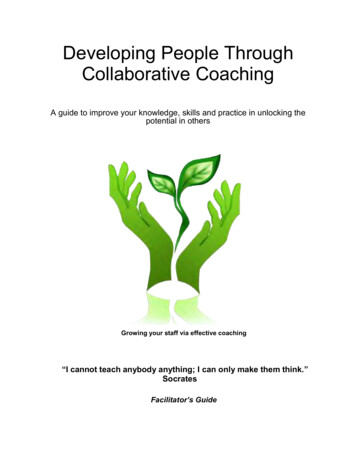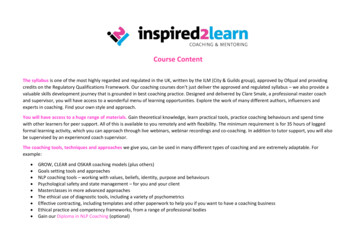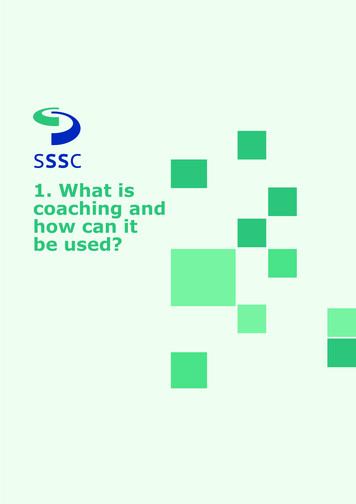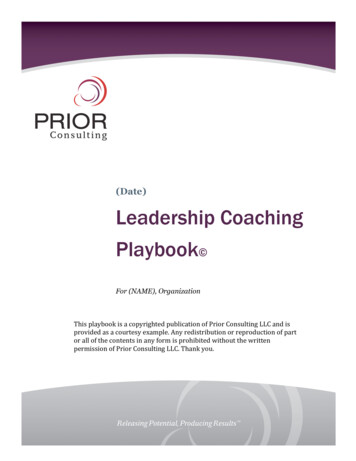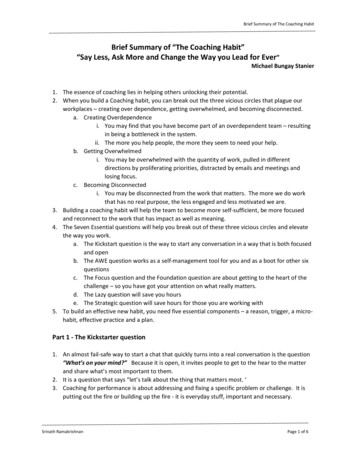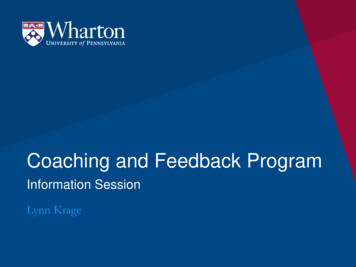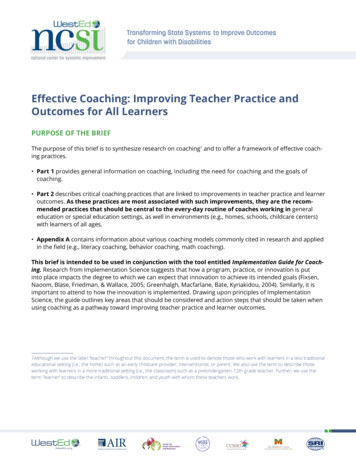
Transcription
Effective Coaching: Improving Teacher Practice andOutcomes for All LearnersPURPOSE OF THE BRIEFThe purpose of this brief is to synthesize research on coaching1 and to offer a framework of effective coaching practices. Part 1 provides general information on coaching, including the need for coaching and the goals ofcoaching. Part 2 describes critical coaching practices that are linked to improvements in teacher practice and learneroutcomes. As these practices are most associated with such improvements, they are the recommended practices that should be central to the every-day routine of coaches working in generaleducation or special education settings, as well in environments (e.g., homes, schools, childcare centers)with learners of all ages. Appendix A contains information about various coaching models commonly cited in research and appliedin the field (e.g., literacy coaching, behavior coaching, math coaching).This brief is intended to be used in conjunction with the tool entitled Implementation Guide for Coaching. Research from Implementation Science suggests that how a program, practice, or innovation is putinto place impacts the degree to which we can expect that innovation to achieve its intended goals (Fixsen,Naoom, Blase, Friedman, & Wallace, 2005; Greenhalgh, Macfarlane, Bate, Kyriakidou, 2004). Similarly, it isimportant to attend to how the innovation is implemented. Drawing upon principles of ImplementationScience, the guide outlines key areas that should be considered and action steps that should be taken whenusing coaching as a pathway toward improving teacher practice and learner outcomes.1Although we use the label “teacher” throughout this document, the term is used to denote those who work with learners in a less traditionaleducational setting (i.e., the home) such as an early childcare provider, interventionist, or parent. We also use the term to describe thoseworking with learners in a more traditional setting (i.e., the classroom) such as a prekindergarten-12th grade teacher. Further, we use theterm “learner” to describe the infants, toddlers, children, and youth with whom these teachers work.1
PART 1: GENERAL INFORMATION ON COACHINGThe Promise of CoachingEducation holds a clear affinity for coaching as a method for improving teacher practice and learner outcomes. In fact, support for coaching can be found across research and literature from general education(Shanklin, 2006; Neumann & Wright, 2010; Biancarosa, Bryk, & Dexter, 2010) and special education (Kretlow& Bartholomew, 2010; Winton, Snyder, & Goffin, 2015) focused on infants, toddlers, young children (Snyder,Hemmeter, & Fox, 2015; Israel, Carnahan, Snyder, & Williamson, 2013) as well as learners in the K-12 schoolsetting (Kretlow & Bartholomew, 2010; Horner, 2009). Despite the fact that coaching research suggeststhat it does not necessarily lead to improved outcomes among teachers and learners (Gamse, Jacob, Horst,Boulay, Unlu, 2008; Bean, Draper, Hall, Vandermolen, & Zigmond, 2010), Joyce and Showers’ (1982) seminalresearch remains one of the most resounding messages about the potential for coaching. These researchers found that the common form of professional development (PD) such as PD; infrequent and decontextualized training resulted in the implementation of less than 20 percent of new practices in the classroomsetting. Conversely, Joyce and Showers found that training reinforced by ongoing coaching led to 80 percentto 90 percent of implementation of new practices.Coaching also is included as an aspect of effective implementation across various fields, including education (Fixsen, Blase, Naoom, Wallace, & Friedman, 2005), health services (Damschroder, Aron, Keith, Kirsch,Alexander, & Lowery, 2009), and nursing (Kitson, Harvey, & McCormack, 1998). Implementation frameworksfrom these different fields promote the idea that coaching helps practitioners bridge the research-to-practice gap by continually developing and honing teachers’ skills learned in initial trainings.Drawing from this research, coaching has been suggested as a strategy for improving teaching and learningacross overall systems (e.g., Metz, 2015; Sugai & Horner, 2006). Although less is known about the degree towhich coaching can transform teacher practices within an entire system as well as the practice of individualteachers, a variety of educational organizations and technical assistance networks have embraced coachingfor this purpose (e.g., The State Implementation of Scaling Up of Evidence-Based Practices, or SISEP; PositiveBehavior Intervention and Supports Technical Assistance Center).Perhaps because coaching has been so widely embraced, many different models of this form of PD nowexist in a host of learning environments (i.e., day care, classroom, or home). Coaches may provide support with early learning, literacy, math, or behavior as they work in these different settings. Subsequently,coaches often may fulfill a wide range of responsibilities. For example, coaches may analyze data, maintainaction plans or other records of progress, or directly work with teachers. For descriptions of models and keyresponsibilities, refer to the Appendix.However, despite the variability in coaching roles and responsibilities, few certification programs or university preparation programs exist that specifically train and produce coaches (Denton & Hasbrouck, 2009;Galluci, Van Lare, Yoon, & Boatright, 2010). Given variation that occurs with coaching- as well as the expectation that coaching produces powerful changes in teaching and learning-educators and leaders alike benefitfrom a clear understanding of who may be coached, who typically serves as coach, and the goals of coaching. Moreover, it is important to ensure that coaching consists of effective coaching practices. The followingsections address these topics.2
Who Is a Coach? Who Is Coached?Frequently, the role of the coach is performed by a range of adults. For example, general education andspecial education teachers with expertise in instructional practices and school psychologists often assumethe role of coach (Denton & Hasbrouck, 2009; Kretlow & Bartholomew, 2010; Snyder et al., 2015; Stormont& Reinke, 2012). Although new general and special education teachers oftentimes are coached, experiencedteachers may benefit from coaching as well (Kretlow & Bartholomew, 2010). In the context of early learning,parents or caregivers may be coached (Snyder et al., 2015). Coaching also has occurred within the juvenilejustice setting, with experts in behavior serving as coaches for facility-level leadership teams and juvenilecorrection officers (Sprague, Scheuermann, Wang, Nelson, Jolivette, & Vincent, 2013).Some educational organizations suggest that coaching ratios should remain small (e.g., one coach perschool or early childcare setting); however, in the real-world application of coaching, these ratios may not befeasible (International Reading Association, 2004; Mangin, 2009). Existing research on coaching has not yetoffered definitive recommendations for ideal teacher-coach ratios.Goals of CoachingDespite the diversity that exists with coaching, the goals of this form of professional development remainfocused on two areas: Improving teaching practice, with a particular emphasis on increasing the use of practices shown to behighly effective, including evidence-based practices (Knight, 2009; Kretlow & Bartholomew, 2010; Neufeld& Roper, 2003; Snyder et al., 2015). Improving learner academic and behavioral outcomes through improved teaching practices (Bean, Knaub,& Swan, 2000; Joyce & Showers, 2002; Kretlow & Bartholomew, 2010; Snyder et al., 2015).The next section will present research on coaching practices that are most likely to lead to the achievementof these two goals.3
PART 2: EFFECTIVE COACHING—IMPROVING TEACHER PRACTICE ANDLEARNER OUTCOMESDefining Effective Coaching PracticesExperimental and qualitative research supports the idea that several specific coaching practices are linkedto improved teacher practice. In fact, these coaching practices can be effective in the early childhood setting(Snyder et al., 2015; Winton et al., 2015) as well as in the K-grade 12 classroom (Biancarosa, Bryk, & Dexter,2010; Kretlow & Bartholomew, 2010; Neuman & Cunningham, 2009; Wehby, Maggin, Partin, & Robertson,2012). Although an emerging line of research exists on coaching teachers of infants, toddlers, and the veryyoungest learners (Snyder et al., 2015), less is known about the impact of these coaching practices on thesechildren. Despite this point, coaching practices with the strongest evidence for improving teacher practiceand learner outcomes include the following:See Figure 1.This section of the brief provides a review of thesehigh-quality coaching practices. It is important to notethat as originally found by Joyce and Showers (1982),these coaching practices typically occur after teachersparticipate in didactic instruction (e.g., workshops,institutes, trainings) as a way to ensure content isapplied to the learning environment.Figure 1. Effective Coaching Practicesilding Stra-BuecObserveFeedbackgiesteObservationModeling (also referred to as “demonstration”)Performance FeedbackAlliance-Building Strategies also referred to as“relationship-building strategies”)Allian ModelSource: Pierce,2015, p. 27.ObservationObservation refers to direct monitoring of the teacher in a learning environment. The primary purposeof observation is to enable a coach to engage in other coaching practices such as modeling or providingperformance feedback (Kretlow & Bartholomew, 2010; Neuman & Cunningham, 2009; Stormont & Reinke,2012; Snyder et al., 2015). For example, observation allows the coach to collect data on the teacher’s use ofan evidence-based practice; or, it may provide opportunities for the coach to model the use of that sameevidence-based practice. Given that observation is considered as the entry point for using other coachingpractices, it is often studied in tandem with other coaching practicesModelingModeling occurs when a coach demonstrates how to use the practice. Modeling is most typically used bya coach when a teacher is not correctly using a practice with the learner or does not know how to use thatpractice. However, modeling may also occur when learners are not present (i.e., during a training or duringa postobservation meeting with the teacher). The primary purpose of in-classroom-situated modeling is tohelp the teacher better understand how the accurate use of a practice “looks” and how it impacts the performance of the learner (Kretlow and Bartholomew, 2010; Neuman & Cunningham, 2009; Winton et al., 2015).4
Modeling can support improvements in teachers’ academic practices (Biancarosa et al., 2010; Kimet al., 2011; Kretlow, Cooke, & Wood, 2012; Neuman & Cunningham, 2009; Neuman & Wright, 2010) andbehavioral practices (Barton, Chen, Priblle, Pomes, & Kim, 2013; Bethune & Wood, 2013; Kohler, Crilley,Shearer, & Good, 1997; Kretlow & Bartholomew, 2010). Coaching that integrates modeling supports improvements in learner academic outcomes (Biancarosa et al., 2010; Kim et al., 2011; Neuman & Cunningham, 2009; Neuman & Wright, 2010; for specialeducation settings, see Barton et al., 2013; Bethune & Wood, 2013). Modeling also supports improvements in learner behavioral outcomes (Domitrovich, Gest, Jones, Gill,& DeRousie, 2010; Filcheck, McNeil, Greco, & Bernard, 2004).Performance FeedbackProviding performance feedback is a third critical coaching practice and entails the coach’s presentationof data to the teacher on his or her teaching practice. Providing this type of feedback is highly effective inimproving early childhood teacher practice (Shannon, Snyder, & McLaughlin, 2015; Artman-Meeker & Hemmeter, 2012; Diamond & Powell, 2011) as well as K-grade 12 teacher practice and learner outcomes (Cornelius & Nagro, 2014; Scheeler, Ruhl, & McAfee, 2004; Solomon, Klein, & Politylo, 2012; Stormont, Reinke,Newcomer, Marchese, & Lewis, 2015). In fact, giving feedback is so effective in improving teacher practiceand K-grade 12 learner outcomes that it is considered by some researchers as an evidence-based practice(Fallon, Collier-Meek, Maggin, Sanetti, & Johnson, 2015; Solomon et al., 2012; Stormont et al., 2015). Somestudies of performance feedback also suggest early learning outcomes may also improve (Snyder et al.,2015).In addition, research on feedback suggests the following: Feedback is most effective when it is specific, positive, timely, and corrective, if warranted (Scheeler et al., 2004; Solomon et al., 2012). Specific feedback, as opposed to general feedback, includes precise information about teaching practices that benefit learners. General feedback (e.g., “Great teaching!”) may not explain to teachers whysome teaching practices are more effective than others. Specific feedback clarifies how teachers’ practices directly impact learning (e.g., “During small-group instruction, four out of five learners were activelyengaged in the task you assigned”). Positive feedback includes overt statements of praise for the teacher’s use of specific practices (e.g.,“Good job using ‘stating behavioral expectations’ during the morning meeting”). Corrective feedback, used only when warranted, involves the use of statements and questions thatsuggest that a change to teaching practice is needed (e.g., “Learners were redirected seven times in the20-minute lesson. How can we increase praise for learners while reducing redirections?”). The timeliness of feedback also seems to be important. Feedback is considered timely when it is delivered within roughly the same day of an observation (Scheeler et al., 2004). Coaches can use several delivery mechanisms for providing feedback. While feedback can be discussed in a face-to-face postobservation conference (Kretlow & Bartholomew,2010; Conroy, Sutherland, Algina, Wilson, Martinez, & Whalon, 2014; Snyder et al., 2015), it also may beprovided via bug-in-ear technology (Scheeler et al., 2004). This technology allows for a coach to observe(i.e., visual and provide feedback). Some recent research draws on the use of video-based technology to present written and verbal feedback (Israel, Carnahan, Snyder, & Williamson, 2013; Artman-Meeker, Fettig, Barton, Penney, & Zeng,2015). It is unclear, however, whether this format for providing feedback improves both teacher practiceand outcomes among learners of all ages, as much of this research focuses on early learners5
Feedback may be based on informal or formal data that are presented verbally, graphically, orboth (Neuman & Cunningham, 2009; Scheeler et al., 2004; Snyder et al., 2015). Formal data may consist of learner engagement data, whereas informal data may consist of qualitativenotes on the learning environment. Graphs, charts, and oral feedback are frequently used to deliver feedback (Solomon et al., 2012). Suchfeedback may be particularly powerful when used to develop action plans, goals, or to help teachersengage in problem solving processes as they attempt to implement new practices (Shannon, Snyder, &McLaughlin, 2015).Alliance Building StrategiesA final critical coaching practice includes the development of a positive teacher–coach relationship, alsoreferred to as alliance (Ippolito, 2010; Snyder et al., 2015; Mraz, Algozzine, & Watson, 2008; Neufeld & Roper,2003; Shanklin, 2006; Wehby et al., 2012). Strong alliance between teachers and coaches establishes a solidfoundation for subsequent work between the dyad. Within the early learning environment, alliance hasbeen referred to as a “collaborative partnership” (Snyder et al., 2015, p. 135), which is a cornerstone of productive coaching. Some research from early learning suggests that alliance is also important across coaches,teachers, and families (Basu, Salisbury & Thorkidlsen, 2010; Rush & Shelden, 2011).Research on teacher–coach alliance offers the following conclusions: Alliance is shaped by several factors: interpersonal skills (Ippolito, 2010; Neuman & Wright, 2010; Walpole & Blamey, 2008), collaboration skills (Neuman & Wright, 2010; Vanderburg & Stephens, 2009; Walpole, McKenna,Uribe-Zarain, & Lamitina, 2010; Shannon, Snyder, & McLaughlin, 2015), the coach’s expertise in area in which he or she is coaching (Cantrell & Hughes, 2008; Chval et al.,2010; Gallucci et al., 2010; Snyder et al., 2015). An alliance may also be shaped by teachers’ perceptionsof coaching as evaluative (Mangin, 2009; Matsumura, Garnier, & Resnick, 2010; Matsumura, Sartoris,Bickel, & Garnier, 2009; Walpole et al., 2010). Specific strategies can be used by coaches to build alliance (Becker, Bradshaw, Domitrovich, & Ialongo, 2013; Ippolito, 2010; March & Gaunt, 2013; Wehby et al., 2012). Positive teacher-coach alliance correlates with improved teacher practice; however, it is unclearhow alliance impacts learner outcomes (Wehby et al., 2012). The use of specific alliance building strategies can lead to increased use of behavioral interventions by teachers (See Figure 2; Pierce, 2015).6
Table 1 summarizes critical coaching practices and offers suggestions for when these practices can be usedby coaches.Table 1. Effective Coaching Practices and Suggestions for UseEffective CoachingPracticesDescriptionWhen UsedObservationWatching the teacher2 in the classroom environment use aspecific program, intervention, or practice (including EBPs)Every coaching cycleModeling, alsoreferred to asdemonstrationShowing the teacher how to use a specific program,intervention, or practice (including EBP)Based on need(e.g., when teacheris unfamiliar withpractice or usespractice incorrectly)PerformanceFeedbackPresenting formal or informal data about the teacher’s use ofa specific program, intervention, or practice (including EBP)Every coaching cycleCharacteristics of effective feedback: Specific Positive Corrective (if warranted) TimelyDelivery mechanisms: Verbal, written, or graphical data presented during pre–postobservation conferences with a teacher or in the momentof teaching (e.g., using bug-in-ear technology)Alliance BuildingStrategiesUsing specific strategies that relate to factors of alliance tobuild a positive relationship in a teacher–coach dyadEvery coaching cycleFactors of alliance: Interpersonal skills Collaboration Expertise Conveying coaching is non-evaluativeExamples of alliance-building strategies: Empathetic listening Restating and summarizing information conveyed by theteacher Conveying expertise in teaching and deep content-areaknowledge Identifying and working toward teachers’ goals and needsNote. EBP Evidence-based practice.2Although we use the label “teacher” throughout this document, the term is used to denote those who work with learners in a less traditional educational setting (i.e., the home) such as an early childcare provider, interventionist, or parent. We also use the term to describe thoseworking with learners in a more traditional setting (i.e., the classroom) such as a prekindergarten-grade 12 teacher. Similarly, we use theterm “learner” to describe the infants, toddlers, children, and youth with whom these teachers work.7
Strategies for Building AllianceFigure 2 summarizes the strategies coaches can use to build alliance with teachers. Strategies are listed inthe row on the right. These strategies correspond to three primary factors of alliance (i.e., interpersonalskills, collaboration, and expertise). For example, when a coach summarizes teacher comments, that coachmay be showing strong interpersonal skills. Strong interpersonal skills are one factor in building alliance.Figure 2. Coaching Strategies to Build Alliance with TeachersInterpersonal Skills:Effective communication.Building trust.Nonevaluative &nonjudgmental language.Collaboration:Meeting needs and goals.Conveying that improvingteaching is teamwork. Summarize: “What I hear from your comments is.”Open-ended questions: “Can you tell me more about that?Affirm difficulty of change: “This is really hard!”Nonevaluative language: “Coaching is about supporting yourteaching practice, not about evaluating how you teach.” Refer to past accomplishments: “This week you hoped toaccomplish ”Refer to current goal: “Your goal for this week is .Help teacher progress toward goal: “Let’s talk about what we’lldo to meet that goal. I can . What do you think you will try to do.” Expertise:In teaching in the contentarea. Refer to effective teaching practices: “Learners who struggleto show mastery benefit from explicit and systematic instruction.Explicit means.”Convey deep content-area knowledge: “We know that effectivereading instruction focuses on the five pillars of reading. Theseinclude.”Explain complex concepts succintly: “The Tier 3 learner may showchallenging behavior because.”Source: Pierce, 2015, p. 138.8
APPENDIXThis appendix contains a list of coaching models commonly found in research on this form of professionaldevelopment. Although commonalities exist across these descriptions of coaching, individual coaches oftenshow great variation in how they approach working with teachers (Deussen, Coskie, Robinson, & Autio,2007; Denton & Hasbrouck, 2009; Snow, Ippolito, & Schwartz, 2006). With this point in mind, it is importantthat coaching relies on the specific practices linked to improved teacher practice and learner outcomes asdescribed in Part 2 of this brief, rather than a particular coaching model.Instructional Coaching Across Content AreasDenton, C. A., & Hasbrouck, J. (2009). A description of instructional coaching and its relationship to consultation. Journal of Educational and Psychological Consultation, 19(2), 150–175.Knight, J. (2007). Instructional coaching: A partnership approach to improving instruction. Thousand Oaks, CA:Corwin Press.Literacy CoachingBean, R., & Isler, W. (2008). The school board wants to know: Why literacy coaching? Urbana, IL: Literacy Coaching Clearinghouse.Retrieved from lBoardBrief.pdfDeussen, T., Coskie, T., Robinson, L., & Autio, E. (2007). “Coach” can mean many things: Five categories of literacy coaches in Reading First (Issues and Answers Report, REL 2007–No. 005). Washington, DC: U.S.Department of Education, Institute of Education Sciences, National Center for Education Evaluationand Regional Assistance, Regional Educational Laboratory Northwest.Gamse, B. C., Jacob, R. T., Horst, M., Boulay, B., Unlu, F., Bozzi, L., Rosenblum, S. (2008). Reading First ImpactStudy final report (NCEE 2009-4038). Washington, DC: National Center for Education Evaluation andRegional Assistance, Institute of Education Sciences.International Reading Association. (2004). The role and qualifications of the reading coach in the United States.Newark, DE: Author.International Reading Association. (2006). Standards for middle and high school literacy coaches. Newark, DE:International Reading Association.McKenna, M. C., & Walpole, S. (2008). The literacy coaching challenge: Models and methods for grades K-8 (Vol.9). New York: Guilford Press.Sailors, M., & Shanklin, N. L. (2010). Introduction: Growing evidence to support coaching in literacy andmathematics. Elementary School Journal, 111(1), 1–6.9
Mathematics CoachingHansen, P. (2013). Mathematics coaching handbook: Working with teachers to improve instruction. New York:Routledge.Hull, T. H., Balka, D. S., & Miles, R. H. (Eds.). (2009). A guide to mathematics coaching: Processes for increasingstudent achievement. Thousand Oaks, CA: Corwin Press.Yopp, D., Burroughs, E. A., Luebeck, J., Heldema, C., Mitchell, A., & Sutton, J. (2011). How to be a wise consumer of coaching. Journal of Staff Development, 32(1), 50–53.Cognitive CoachingCosta, A. L., & Garmston, R. J. (1994). Cognitive coaching: A foundation for renaissance schools. Norwood, MA:Christopher-Gordon Publishers.Peer CoachingJoyce, B. R., & Showers, B. (2002). Student achievement through staff development. Alexandria, VA: Associationfor Supervision and Curriculum Development.Showers, B., & Joyce, B. R. (1996). The evolution of peer coaching. Educational Leadership, 53(6), 12–16.Coaching in the Early Childhood SettingArtman-Meeker, K., Fettig, A., Barton, E. E., Penney, A., & Zeng, S. (2015) Applying an evidence-based framework to the early childhood coaching literature. Topics in Early Childhood Special Education, 35(3),183–196.Kucharczyk, S., Shaw. E., Smith Myles, B., Sullivan, L., Szidon, K., & Tuchman-Ginsberg, L. (2012). Guidanceand coaching on evidence-based practices for learners with autism spectrum disorders. Chapel Hill, NC:University of North Carolina, Frank Porter Graham Child Development Institute, National Professional Development Center on Autism Spectrum Disorders.Snyder, P. A., Hemmeter, M. L., & Fox, L. (2015). Supporting implementation of evidence-based practicesthrough practice-based coaching. Topics in Early Childhood Special Education, 35(3), 133–143.Snyder, P., Hemmeter, M. L., Meeker, K. A., Kinder, K., Pasia, C., & McLaughlin, T. (2012). Characterizing keyfeatures of the early childhood professional development literature. Infants and Young Children,25(3), 188–212.Snyder, P. A., Denney, M. K., Pasia, C., Rakap, S., & Crowe, C. (2011). Professional development in earlychildhood intervention: Emerging issues and promising approaches. In C. Groark (Series Ed.) & L. A.Kaczmarek (Vol. Ed.), Early childhood intervention: Shaping the future for children with special needs andtheir families: Vol. 3 (pp. 169–204). Santa Barbara, CA: Praeger/ABC-CLIO.Tout, K., Isner, T., & Zaslow, M. (2011). Coaching for quality improvement: Lessons learned from quality ratingand improvement systems (QRIS). (Research Brief). Washington, DC: Child Trends.10
Behavioral Coaching, Sometimes Referred to as Behavioral ConsultationBecker, K. D., Darney, D., Domitrovich, C., Keperling, J. P., & Ialongo, N. S. (2013). Supporting universal prevention programs: A two-phased coaching model. Clinical Child and Family Psychology Review, 16(2),213–228.Bradshaw, C. P., Pas, E. T., Goldweber, A., Rosenberg, M. S., & Leaf, P. J. (2012). Integrating school-widepositive behavioral interventions and supports with tier 2 coaching to student support teams: ThePBISplus model. Advances in School Mental Health Promotion, 5(3), 177–193.Hershfeldt, P. A., Pell, K., Sechrest, R., Pas, E. T., & Bradshaw, C. P. (2012). Lessons learned coaching teachers in behavior management: The PBISplus coaching model. Journal of Educational and PsychologicalConsultation, 22(4), 280–299.Kucharczyk, S., Shaw, E., Smith Myles, B., Sullivan, L., Szidon, K., & Tuchman-Ginsberg, L. (2012). Guidance andcoaching on evidence based practices for learners with autism spectrum disorders. Chapel Hill, NC: TheUniversity of North Carolina, Frank Porter Graham Child Development Institute, National Professional Development Center on Autism Spectrum Disorders.Pas, E. T., Bradshaw, C. P., & Cash, A. H. (2014). Coaching classroom-based preventive interventions. In M. D.Weist, N. A. Lever, C. P. Bradshaw, & J. S. Owens (Eds.), Handbook of school mental health (pp. 255–267). New York, NY: Springer.Reinke, W. M., Stormont, M., Webster-Stratton, C., Newcomer, L. L., & Herman, K. C. (2012). The incredibleyears teacher classroom management program: Using coaching to support generalization to real-world classroom settings. Psychology in the Schools, 49(5), 416–428.Stormont, M., & Reinke, W. M. (2012). Using coaching to support classroom-level adoption and use of interventions within school-wide positive behavioral interventions and support systems. Beyond Behavior,21(2), 11–19.This National Center for Systemic Improvement response was produced under U.S. Department of Education, Office of Special Education Programs contract No. H326R140006. The views expressed herein do notnecessarily represent the positions or policies of the U.S. Department of Education. No official endorsementby the U.S. Department of Education of any product, commodity, service, or enterprise mentioned on thiswebsite is intended or should be inferred.11
REFERENCESArtman-Meeker K. M., Hemmeter M. L. (2012). Effects of training and feedback on teachers’ use of classroom preventive practices. Topics in Early Childhood Special Education, 33, 112–123.Artman-Meeker, K., Fettig, A., Barton, E. E., Penney, A., & Zeng, S. (2015) Applying an evidence-based framework to the early childhood coaching literature. Topics in Early Childhood Special Education, 35(3),183–196.Barton, E. E., Chen, C.-I., Pribble, L., Pomes, M., & Kim, Y.-A. (2013). Coaching preservice teachers to teachplay skills to children with disabilities. Teacher Education and Special Education: The Journal of theTeacher Education Division of the Council for Exceptional Children, 36(4), 330–349.Basu, S., Salisbury, C. L., & Thorkildsen, T. A. (2010). Measuring collaborative consultation practices in natural environments. Journal of Early Intervention, 32(2), 127–150.Bean, R. M., Knaub, R., & Swan, A. (2000). Reading specialists in leadership roles. Paper presented at the Annual Meeting of the American Educational Research Association, New Orleans, Louisiana.Bean, R. M., Draper, J. A., Hall, V., Vandermolen, J., & Zigmond, N. (2010). Coaches and coaching in ReadingFirst schools: A reality check. Elementary School Journal, 111(1), 87-114Becker, K. D., Bradshaw, C. P., Domitrovich, C., & Ialongo, N. S. (2013). Coaching teachers to improve implementation of the good behavior game. Administration and Policy in Mental Health and Mental HealthServices Research, 40(6), 482–493.Bethune, K. S., & Wood, C. L. (2013). Effects of coaching on teachers’ use of function-based interventions forstudents with severe disabilities. Teacher Education and Special Education: The Journal of the TeacherEducation Division of the Council for Exceptional Children, 36(2), 97–114.Biancarosa, G., Bryk, A. S., & Dexter,
and to offer a framework of effective coach-ing practices. Part 1 provides general information on coaching, including the need for coaching and the goals of coaching. Part 2 describes critical coaching practices that a
